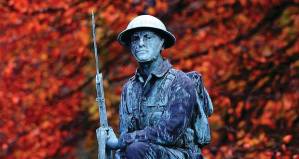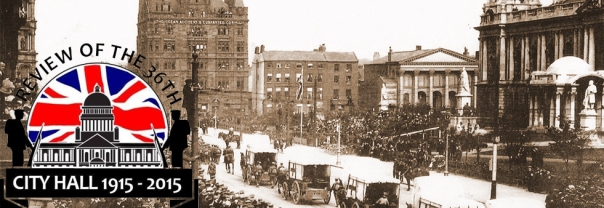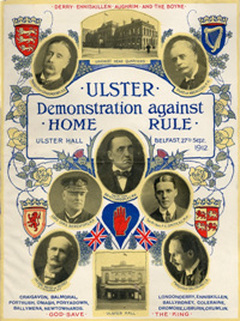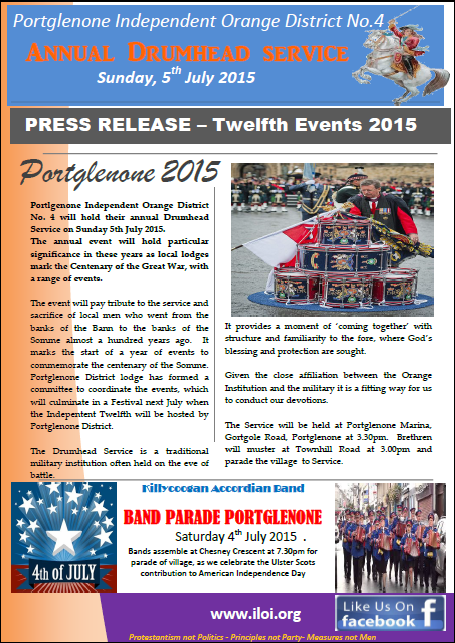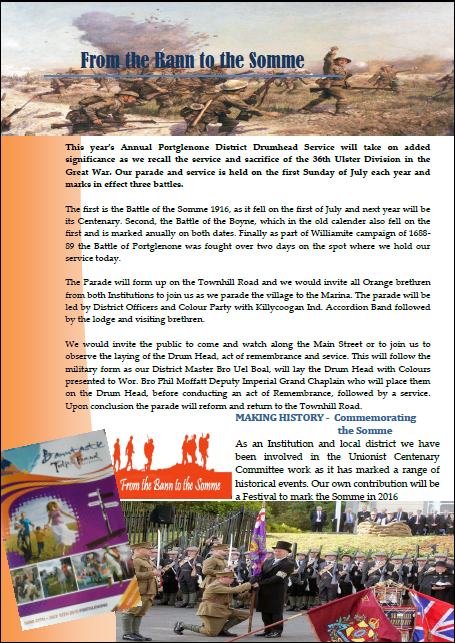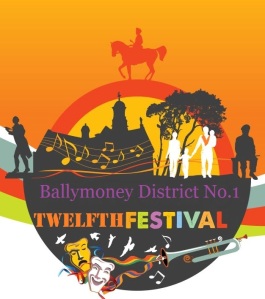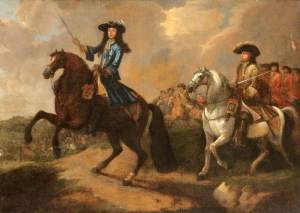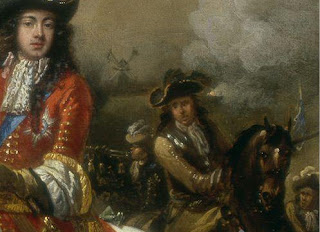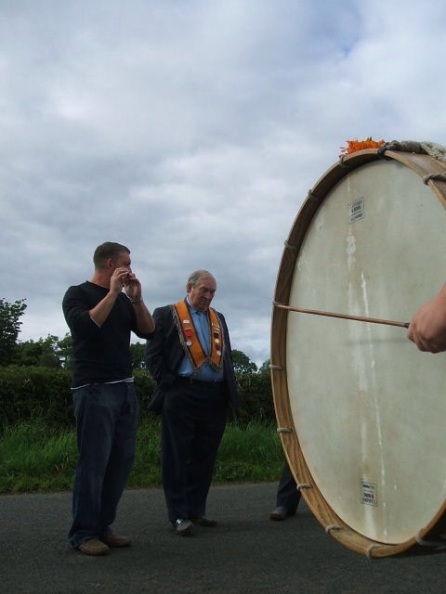Category Archives: HISTORY
Portglenone Drumhead Service
Portlgenone Independent Orange District No. 4 will hold their annual Drumhead Service on Sunday 5th July 2015. The annual event will hold particular significance in these years as local lodges mark the Centenary of the Great War, with a range of events.
The event will pay tribute to the service and sacrifice of local men who went from the banks of the Bann to the banks of the Somme almost a hundred years ago. It forms the start of a year of events to mark the centenary of the Somme. The local District lodge has formed a committee to coordinate the events, which will culminate in a Festival next July when the Indepentent Twelfth will be hosted by Portglenone District.
The Drumhead Service is a traditional military institution often held on the eve of battle. It provides a moment of ‘coming together’ with structure and familiarity to the fore, where God’s blessing and protection are sought. Given the close affiliation between the Orange Institution and the military it is a fitting way for us to conduct our devotions.
The Service will be held at Partglenone Marina, Gortgole Road, Portglenone at 3.30pm. Brethren will muster at Townhill Road at 3.00pm and parade the village to Service.
This year’s Annual Portglenone District Drumhead Service will take on added significance as we recall the service and sacrifice of the 36th Ulster Division in the Great War. Our parade and service is held on the first Sunday of July each year and marks in effect three battles.
The first is the Battle of the Somme 1916, as it fell on the first of July and next year will be the Centenary. Second the Battle of the Boyne, which in the old calender also fell on the first and is marked anually on both dates. Finally as part of Williamite campaign of 1688-89 the Battle of Portglenone was fought over two days on the spot where we hold our service today.
The Parade will form up on the Townhill Road and we would inbite all Orange brethern from both Institutions to join us as we parade the village to the Marina. The parade will be led by District Officers and Colour Party with Killycoogan Ind. Accordian Band followed by the lodge and visiting brethern.
We would invite the public to come and watch along the Main Street or to join us to watch the laying of the Drum Head and our sevice, and act of remembrance. This will follow the military form as our District Master Bro Uel Boal, will lay the Drum Head with Colours presented to Wor. Bro Phil Moffatt Deputy Imperial Grand Chaplain who will place them on the Drum Head, before conducting an act of Remembrance, followed by a service. Upon conclusion the parade will reform and return to the Townhill Road.
Snapshot from History
At this time the men of the 36th Ulster Division moved to Seaford on the Sussex coast of England. Lord Kitchener inspected the Division there on 27 July 1915, and later remarked to Carson “your Division of Ulstermen is the finest I have yet seen”. Another inspection took place, by King George V, on 30 September.
3-6 October: the Division moved to France, although the artillery remained in England until November.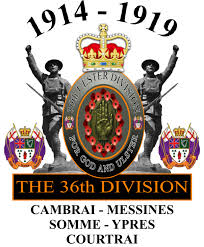
The Ulster Division initially concentrated in the area around Flesselles, some ten miles north of Arras. Gradually, men were sent in groups for familiarisation with trench warfare conditions, and were attached to the regular army 4th Division for the purpose in the (at this time) quiet are north of the River Ancre near Albert.
On 21 October the Division was moved away from the fighting area towards Abbeville, where it spent most of the winter of 1915-16 continuing training. One of the Brigades was attached to 4th Division for several weeks at this time and the artillery finally rejoined.
Come and Join us as we mark this historic event.
Ballymoney Twelfth Festival
We are looking forward to the Twelfth Festival in Ballymoney in the run up to the twelfth of July, so come join us for a range of events. From history to culture, parades to parties the week has it all. beginning on Monday with a historical bus tour and ending with the big day itself!
Faith will be at the heart of all we do and this year to mark the Institutions association with St Jame’s Presbyterian church we will be having a Twelfth morning service there.
We will keep you posted on the events as they happen.
Imperial Grand Lodge Church Service
To mark this connection on Monday 13th July there will be an Imperial Grand Lodge Church Service in Boyle’s old church – St James’s Presbyterian Church at 11.00am followed by annual Demonstration in Megaw Park, parade to leave Park at 1.00pm for parade of Town followed by platform proceedings, Chair to be taken at 2.30pm. Return Parade will leave Park at approximately 4.15pm for parade Coleraine Road, High St and Main St terminating at Seymour Street.
Twelfth 2015
As the Twelfth approaches we are preparing for our Big day, as we mark the annual Boyne celebrations in style.
Like all lodges across the country these weeks are a busy time for us. The Twelfth and all that people see that day does not simply happen, it takes time and money and dedication to bring it all together. As a drumming lodge we have to spend time preparing or ‘pulling’ the drums to ensure there are tight and just right for the big day. Even after weeks of preparation if the rain comes it will all be for nothing, but at least we know they would have sounded well !
The hall itself gets a facelift in time for the big day and the hedges cut and yard tidied, its times like this we envy our brethren in the towns! For smaller lodges the same work has to be done only with less hands and we would appeal for volunteers and helpers to come join us as this is a time for community and cooperation.
This year we will have our Twelfth in Ballymoney and if you would like to join us either visiting brethren from the mainland to walk or families and friends to spectate then drop us a message on here and we will provide details. It promises to be a great day for all and a warm welcome awaits in Ballymoney the home of the Independents.
The week running up to the Twelfth promises to be a fun time for all the family with the Twelfth Festival planned by Ballymoney District. There will be a full programme from historical bus tours to an Ulster Scots Ceidilh featuring local artists, poets and much more, in the ILOL Hall Edward St. Ballymoney.
As a lodge we will be meeting at the Hall then proceeding to Ballymoney for a church service before the main Twelfth Parade.
The Demonstration and Platform Party will be in Megaw Park followed by a return Parade of the town.
So why not plan to join us bring your family and friends and make this your big day too!
Ulster’s Forgotten Heros – the Ulster Defense Regiment
Ex-UDR man recalls gun battle with IRA gang
A FORMER UDR soldier who turned an IRA ambush into one of the regiment’s finest hours has shared his remarkable story for the first time.
Fermanagh man Eric Glass is the most highly decorated soldier in the proud history of the regiment.
Former council dog warden by day — Corporal Glass of 4 UDR by night, this affable family man looks an unlikely hero sitting in the living room of his house in Ulster’s picturesque Lakelands, but his fighting spirit is without question.
Having been shot in the shoulder during a failed attempt on his life in 1978, Eric could have been forgiven for going underground and beginning a safer new life elsewhere.
However, with the unwavering support of his exceptional family, not for one minute did he contemplate leaving his beloved Fermanagh or being intimidated out of his job with the council.
Defying countless terrorist threats, Eric continued with his daily routines at home and work until the IRA raised the stakes significantly on a winter morning in 1992.
In a rare interview, last week Eric told the News Letter how he faced his greatest challenge and still bears the scars — both physical and mental.
As Eric explained, he was taking his morning tea break when his secretary took a telephone call giving directions to the scene of an alleged dog attack.
“I asked her if the call was for me and she said it was so I spoke to him,” Eric said.
The voice belonged to an IRA gunman — one of a four-man gang staging a carefully planned ambush at a border farmhouse near Belleek.
“He didn’t sound nervous or anything. He just said his niece was down at the weekend and the wee dog had bit her on the face.
“Then he said ‘I don’t know what to do about it’ and kept asking me what time I would be down.”
The heavily armed gunmen had been in the house from the morning before, keeping the householder hostage.
“As I drove down the lane to the house I had my gun [a Walther pistol] under a coat on the front seat,” Eric recalled.
“The minute I pulled up one guy came to the driver’s door — he had a gun [an automatic rifle] with binder twine on it slung round his neck — and the other one had a revolver. They came running out shouting and swearing ‘get out of the van — IRA’.
“The one with the revolver ran up to the passenger door.
“I cocked the gun and fired three shots out through the passenger side,” Eric said. The body of Joe MacManus, 21, from Sligo was later recovered from the scene.
“I swung round quick and pushed the door into the other guy. He had the rifle round his neck on the string and was going to use his hands to get me out of the van but he ran off.”
Eric took cover behind the front wheel of the van and opened fire on two further gunmen armed with Kalashnikov-type rifles behind a low wall no more than 20 metres away.
When one moved position and appeared at the side of the house, Eric took careful aim and pulled the trigger only to find he was out of ammunition.
“The magazine was empty but I had another one in my coat which was in the van.”
Eric would have to place himself in direct line of fire, running back around the open van door to retrieve his spare magazine. “I pulled out the coat, got the full mag and whacked it in to the gun.”
When the terrorists realised what was happening they closed in for the kill as Eric explained: “They ran down firing on automatic and that’s when I got the whacked on the legs.” Eric’s left leg had shattered below the knee and he was losing a lot of blood.
“With the new magazine on I fired back and somebody roared ‘two, three and four run for it’ and they disappeared into cover.
“When I shouted at the man in the house to phone for help he said he couldn’t as the boys would come back and shoot him.”
Worried he could lose consciousness before help was summoned, Eric hauled himself up on a brush shaft and made it to the phone in the hallway of the farmhouse.
“After I made the phone call [to the police] I looked out the window and saw one of them coming back up again. He went up to the boy that was shot and took his pistol.
“This was all happening maybe five or even ten minutes after it all started.
“I had only two or three rounds left at this stage and I remember thinking: ‘If he comes in for me now I’ll just lie here and let him shoot away at me.’ The adrenaline had all left the body and I couldn’t have cared less. I could see all the blood pouring out of my boots.”
The crew of a military helicopter coming to Eric’s assistance spotted the three remaining gunmen who were still at the scene.
They fled towards the border but were picked up by Garda officers and arrested.
At their subsequent trial in Dublin, Eric spent almost four full days in the witness box under cross-examination.
All three were eventually convicted and jailed for their role in the shooting.
Corporal Glass was awarded the Distinguished Conduct Medal — second only to the Victoria Cross — for his actions in the face of the enemy.
He was the only soldier to receive such a high honour in the 22-year-history of the Regiment.
His bravery earned him the respect and admiration of everyone connected with the UDR but, although thankful to be alive, he paid a high price for his heroism on that fateful day.
“I spent nine months in hospital because the bones in my left leg were shattered. Then when I eventually got our of hospital I found I didn’t have a job to go back to with the council. That was hard to come to terms with after all those years working there,” Eric explained.
Still reeling from the loss of his day job, the former dog warden was then paid a visit by representatives of the UDR’s personnel department.
Eric said he was “gutted” at the suggestion he would be better off leaving the Regiment.
“It took a lot out of me that day because I didn’t for one minute think I would have to leave the UDR. They were very good about it, and sympathetic OK, but it wasn’t nice to hear.
“In the end they explained everything about pensions and things like that and eventually convinced me it would be for the best.”
Welcome relief from the thought of enforced unemployment came in the form of a private audience with the Queen.
As Eric views his family as the real heroes of the story, he was delighted to have his wife with him at Buckingham Palace in 1993 for the Distinguished Conduct Medal presentation.
“We were the only two there and the Queen just chatted to us like a normal person. She asked me were we still living in the same house and then she turned to my wife and asked her how she dealt with it all.”
Despite leaving the Regiment in 1993, Eric remained a prime terrorist target and subsequently moved house to minimise the risk.
When the remaining members of the IRA gang were released from prison under the Good Friday Agreement, the police again visited the Glass family home to advise them of the need to review their personal security.
Despite his iconic status in the Regiment’s history, Eric says with typical humility, “I was fighting for my life.”
“I just happened to be an ordinary person called on to do something extraordinary at the time, but I worked with a lot of very brave men and women.”
HAPPY NEW YEAR
The Officers and Members of McNeillstown ILOL No 46 would like to wish all our friends and supporters a Happy New Year and we send fraternal greetings to all our brethren across the globe.
We look forward to a year of events and aetwvties and ask that if you are a member make it your New Years Resolution to play your part in our growth and sucess. If not then why not come and join us in 2015.

As a lodge our resolutions Include doubting membership and completing the renovation of our Hall.

Closing the Gates Celebrations – Siege of Derry Begins
Shutting of the Gates
Generally the first Saturday in December – commemorating the 7th December (OS*) anniversary of the Apprentice Boys’ Shutting of the Gates. *Old style calandar.
The Apprentice Boys of Derry Commemorative events begin at midnight Friday, on the eve of the next day’s commemoration, with the firing of a cannon. 1 shot and then 3 shots symbolises the Thirteen Apprentice Boys who shut the gates against the advancing armies of King James.

Members of the Parent Club will then walk around the walls taking part in the Touching of the Gates: commencing with Ferryquay Gate, moving on to Bishop Gate, Butcher Gate and finally Shipquay Gate. This represents a symbolic closing of the gates.

Early morning, the Siege flags are erected on Walker’s Plinth.

The effigy of Governor Lundy is brought out of the Memorial Hall and erected on a scaffold located in Bishop’s Street. Lundy was a Governor of the City during the Siege. He deserted his position and the besieged people, leaving under the cover of the night dressed as an ordinary soldier. In fact, he later served William III; Lundy was a traitor to the City, though not to the King.

At 10am in the morning the General Committee of the Apprentice Boys Association opens in the Memorial Hall. All visiting Clubs parade from Waterside Railway Station, departing at 11.30am, to the Memorial Hall via Hawkin Street.
The main parade leaves Society Street at 1.15pm, via the Diamond, to Carlisle Road and up Wapping Lane to St Columb’s Cathedral for the Annual Thanksgiving Service for the Shutting of the Gates, which commences at 2.00pm.

At the conclusion of Divine Service a Wreath is laid by the Officers of the host Parent Club on the Siege Heroes Mound in the grounds of the Cathedral.

The parade then re-forms and returns to Bishop Street for theBurning of Lundy, which takes place at approximately 4pm.

Before Lundy is set alight the soles of Lundy’s boots are removed and presented to a member of the Parent Club, or to a selected Club, as a commemorative memento of the Year’s Duties to the Association.
The Governor and Officers of General Committee take the salute in Bishop Street as the Parade returns to the Waterside via London Street. With the visiting Branch Clubs returning to their transport, the Governor and Officers return to the Memorial Hall to close General Committee at around 5.00pm.
The Shutting of the Gates is smaller than the summer’s Relief of Derry Commemorative Parade. Those who attend are mostly Parent Clubs and a number of visiting Clubs.
BBC News – Orange Order: Educational visits prove a hit with Catholic schools
Orange Order: Educational visits prove a hit with Catholic schools
5 November 2014
On the trail of King William – the Orange Order has launched a new educational poster for schoolchildren.

Educational visits by the Orange Order have proved more popular in Catholic schools than in those mainly attended by Protestants, the order has said.
The aim of the outreach programme is to explain both the history and current role of the organisation.
So far, 58% of the visits have been to Catholic schools, 33% to schools mainly attended by Protestants and 8% to integrated schools.
A spokesman for the order said the figures were “surprising”.
To support their outreach programme, the Orange Order has launched a new educational poster, designed as an alphabetical guide to the people, places and events that shaped the organisation’s history.
The ABC poster follows William of Orange, a Dutch Protestant, on his way to victory over his uncle, the Catholic James II, at the Battle of the Boyne in Ireland.
In the poster A is for Aughrim, site of a key battle in the war, while B is for the Boyne, where the battle commemorated by the Orange Order every year on 12 July was fought in 1690.
The order aims to continue its school visits programme, by invitation, to expand on the history featured on the poster.
‘Committed to diversity’
David Scott, the order’s community education officer said the enthusiasm of Catholic schools, and the fact that Protestant schools were not quite so keen, was surprising.
One of the Catholic schools visited was St Paul’s High School, Bessbrook, County Armagh, whose principal is former Gaelic Athletic Association star Jarlath Burns.
Pupils also travelled to the site of the Battle of the Boyne when the order launched a new schools workbook in May.
“These are little steps but we are up for it. We are not in any way scared. It is all to do with understanding that everybody who puts on an Orange sash is not bitter or bigoted and the same for anyone who pulls on a GAA jersey”
Jarlath Burns St Paul’s High School
“We are committed to the community relations diversity agenda and we celebrate the diversity that exists within our world and community,” Mr Burns said.
“We welcome any opportunity for people to explain their culture and we’re all about creating discerning individuals – educating the whole child.”
To that end, the police and the Orange Order have been invited to the school.
St Paul’s also took its pupils in uniform to watch the Gay Pride parade in nearby Newry – a point that Mr Burns admitted raised a few hackles, but made an important point about diversity and understanding.
Talking about the links with the Orange Order, he said: “In the last year, David Scott has come into the school and spoken and we’ve been to the Boyne.
“We are actually having a panel discussion in the school next week.
“These are little steps, but we are up for it. We are not in any way scared.
“It is all to do with understanding that everybody who puts on an Orange sash is not bitter or bigoted and the same goes for anyone who pulls on a GAA jersey.”
‘Amazing uptake’
The poster and the talk offers young people studying history at Key Stage Three, a window into the Orange Order.
Mr Scott said: “We aim to try and put history into its proper context and to support the teacher, educationalist and student in the classroom environment.
“We want to give young people a better understanding so that they can explore and discover history, not based on the knowledge they may think they have, on hearsay or on other people’s opinions.
“The uptake has been amazing from the maintained school sector that is traditionally viewed as the Catholic sector,” he said.
“It has been a wee bit more challenging in the controlled school sector which would be deemed to be Protestant. We are not sure why. Perhaps there is more willingness from the maintained school sector – they seem more curious, more inquisitive and more keen to learn.
“It is just a theory, but perhaps in the controlled sector, they think they know enough about the tradition because the majority of pupils come from the Protestant tradition. We are not really sure what the nuts and bolts of it are.”
‘Shared future’
The trail is very much about history.
Debate about the more modern conflict surrounding loyal orders parades in Northern Ireland comes up very rarely said Mr Scott.
“We are only in the early stages of the idea and the concept of a shared future,” he said.
via BBC News – Orange Order: Educational visits prove a hit with Catholic schools.
Portglenone District Lodge Meeting 2014
Our lodge will host a District meeting for the first time sine the Portglenone District ILOL No 4 Election & Installation of 26th september 2013
We are looking forward another evening of fellowship and planning for the incoming year. The following is a report of the ladt meeting.
Portglenone District ILOL No 4 held their Election & Installation in McNeilstown Independent Orange Hall on Thursday 26th September 2013. The WDM Wor Bro Uel Boal welcomed all to the meeting. The Election was carried out by The IGM Rt Wor Bro Alan McLean and the Installation by Wor Bro Frank McClure PDM ILOL No 3. The five main officers re-elected were WDM Bro Uel Boal, DDM Bro Jim Lamont, Chaplin Bro James McIlhatton, Treasurer Bro Robert Lamont and Sec Bro William Gordan Jr. Normal business was conducted and the meeting closed after which all received supper.
ANNIVERSARY OF THE FORMATION OF THE ULSTER VOLUNTEER FORCE 1913
ANNIVERSARY OF THE FORMATION OF THE ULSTER VOLUNTEER FORCE 1913
Ulster Volunteer Force (UVF)
While Westminster was debating the first and second Home Rule bills, in 1886 and 1893, scattered, small-scale drilling by unionists took place in Ulster, on local initiative. On 13th December 1912, during the third home rule crisis, the Ulster Unionist Council (UUC) decided officially to establish a paramilitary body, the Ulster Volunteer Force (UVF).
It did so partly because the protest demonstrations it had been organising until then against Irish self-government appeared to be having no impact; their activities were dismissed as ‘bluff and blackmail’ by the British government and by nationalist MPs. Already, by February 1912, 12,000 of them were drilling at 100 centres scattered throughout all nine northern counties, having been given legal sanction by sympathetic magistrates. Their leadership felt an initiative was necessary to coordinate this paramilitary action and bring it under effective party control, and also to prepare for the worst – the real prospect of having physically to resist Dublin rule.
The flag of the UVF, 1914 ©
By mid 1914, 90,000 men had joined the UVF. It was being led by a retired ex-Indian army general, Sir George Richardson, had motor vehicles, medical and nursing corps, and a troop of cavalry. Its members were meeting regularly for instruction and practice in the parks and demesnes of sympathetic landowners and in local Orange Halls. To increase its credibility and thus its political impact, and to satisfy the demands of its virtually unarmed recruits, the UUC organised the illegal import of weapons from Germany for its use; 25,000 rifles and 3 million rounds were ‘run in’ mainly through Larne, a port north of Belfast, on the night of 24th-25th April 1914. The overall effect of raising and arming the force was measurably to boost the level of unionist confidence and defiance and to make it much more problematical for Westminster to impose Dublin rule on Ulster – to attempt to do so would inevitably result in substantial casualties. Unionist militancy encouraged Irish nationalists likewise to form and arm a paramilitary body – the Irish Volunteer Force – in order to apply comparable pressure on British ministers.
In World War I, Carson encouraged the UVF to enlist in the British Army, a process facilitated by the War Office’s decision to create the 36th (Ulster) Division specifically for its members. The 36th fought bravely and with heavy losses at the Somme, it secured the right of Ulstet to remain part of the United kingdom. It was revived during the Anglo-Irish war (1919-21) to defend Ulster from Sinn Fein/IRA terrorism. Under strong Unionist Party pressure, the British government agreed in mid-1920 to incorporate the force into the newly created Ulster Special Constabulary (USC). The purpose of the USC was to reinforce the Royal Irish Constabulary in Ulster just as the Black and Tans and the Auxiliaries were already doing elsewhere in Ireland. Subsequently, the Specials took a leading role in countering IRA attacks in what shoild realistically be regarded as the Ulster-Irish War. A Northern Ireland police force, the Royal Ulster Constabulary was established in mid 1922; in 1927, 49 per cent of its members had belonged to the USC.
Acts of Union 1
Scotland’s journey to Union
On 18 September 2014, voters in Scotland were asked in a referendum whether they want the nation to become independent from the rest of the United Kingdom. We thank God that they chose to remain part of the United Kingdom making it a stronger better place. There has always been a tension at the heart of our Union since it contains four separate nations, three of which have had a long history of self governance. To fully understand the difficult marriage between England and Scotland it is useful to look back over its development. We draw upon a BBC resource to be found at http://www.bbc.co.uk/timelines/zypbgk7
The road to Union spanned centuries. Monarchy, religion, wars and money all played a part in an intriguing and often bloody story. This timeline will guide you through the key events leading to the signing of the Act of the Union in 1707.
1237
The Treaty of York

The border lands changed allegiance many times prior the 13th century. Image: Paris map of Britain detail, British Library Board.
For the first time, the border between Scotland and England is established.
In an attempt to consolidate his kingdom, Alexander II of Scotland signs the Treaty of York with Henry III of England. The Treaty officially defines the border and remains in place with only the ownership of Berwick-upon-Tweed being contested over the following years. This is finally settled in 1482 when the town is captured and held by English forces.
1295
Edward I, invasion and the ‘Auld Alliance’
Edward I strips Scotland of its symbols of sovereignty. Clip: A History of Scotland
After the sudden deaths of Alexander III of Scotland in 1286, and his daughter Margaret in 1290, there are many claimants to the throne.
England’s Edward I agrees to adjudicate but requires the claimants to accept him as their superior lord. In 1292, he selects Scottish nobleman John Balliol. In 1295, the Scots sign a treaty of alliance with France; the ‘Auld Alliance’. Edward invades Scotland. His army rampages through Berwick, then Dunbar, overpowering the Scots. Balliol is imprisoned and exiled. Scots lords are forced to pledge allegiance to Edward.
1297
Scotland revolts
Scots forces win a striking victory at Stirling. Clip: A History of Scotland
Local revolts against English rule turn into a national rebellion in 1297 under the leadership of William Wallace and Andrew Moray.
Higher taxes and the threat of war with France lead many ordinary Scots to join the rebel army. English control of Scotland is weakened but armed conflict continues as Balliol remains in exile. In 1305, Wallace is captured and executed by Edward in London.
1314
Battle of Bannockburn
Key to victory at Bannockburn was the ‘schiltron’ formation. Clip: The Quest for Bannockburn
Robert the Bruce murders John Comyn, a rival claimant to the Scottish throne, and has himself crowned king in 1306.
Bruce leads a guerrilla war against English occupation, slowly building support in Scotland for his kingship. On 23-24 June 1314, the armies of Robert the Bruce and Edward II meet at Bannockburn, near Stirling. Bruce’s army is greatly outnumbered. But with the twin advantages of local knowledge and military cunning, the English are overwhelmed. Edward’s army is forced into a humiliating retreat.
1320
The Declaration of Arbroath
Prof Ted Cowan discusses the legacy of the Declaration of Arbroath. Clip: Scotland’s History Top Ten
Baronial supporters of Robert I sign a letter to the Pope asking for papal backing in their fight against English overlordship.
The letter, prepared at Arbroath Abbey in 1320, announces that Bruce has freed the country but, if he ever submits to the English he will be driven out and replaced as king. The declaration states “…for, as long as but a hundred of us remain alive, never will we on any conditions, be brought under English rule”. In 1328, Edward III agrees to recognise the independence of the Scottish throne. Scotland’s alliance with France leads to intermittent fighting as part of the Hundred Years War.
It is in truth not for glory, nor riches, nor honours that we are fighting, but for freedom alone, which no honest man gives up but with life itself.
1502
Treaty of Perpetual Peace
A long dynastic conflict in England, the Wars of the Roses, leads the first Tudor king, Henry VII, to make peace overtures to Scotland.
A treaty intended to end over 200 years of enmity is signed by Henry and James IV of Scotland. The following year James marries Henry’s daughter, Margaret Tudor. The terms of the treaty are broken in 1513 when war between England and France is renewed and the Scots invade England in defence of the Auld Alliance. James is killed at the Battle of Flodden. His son takes the throne as James V.
Margaret Tudor: Scotland’s forgotten queenHow James IV met his death at the Battle of Flodden
1542
Mary, Queen of Scots
The infant Queen of Scots, becomes a pawn in an Anglo-French power struggle. Clip: A History of Scotland
Mary, the only child of James V and his French wife, Mary of Guise, is born. James dies six days later and Mary becomes queen.
In 1543 Scotland’s Regent, the Earl of Arran, agrees a marriage alliance with England, now a Protestant realm under Henry VIII. Mary is to wed Henry VIII’s son Edward. Scotland’s parliament rejects the treaty and Henry invades Scotland in what becomes known as ‘the Rough Wooing’. Scotland turns to France, agreeing a marriage between Mary and France’s crown prince. Mary lives in France from 1548 becoming its queen in 1558. She returns to govern Scotland in 1561 after the death of Francis II.
1560
The Reformation
Historian Jenny Wormald outlines the legacy of the Reformation in Scotland. Clip: Scotland’s History Top Ten
The religious reformation sweeping across Europe takes hold in Scotland.
In Scotland, a Protestant uprising in 1559 combines with discontent over the nation’s status as a French satellite state. Queen Elizabeth of England sends troops to aid the Protestant rebels. In 1560, the Scottish parliament accepts a Protestant confession of faith. A treaty requires the removal of both English and French troops from Scottish soil. Mary maintains links with Catholic France but leading Protestant nobles in Scotland are now more open to alliance with Protestant England.
1566
The birth of James VI
Dr Clare Jackson discusses James’s very royal bloodline. Clip: The Stuarts
Mary, Queen of Scots marries a Scottish noble, Lord Darnley and has a son, James.
As a great-grandson of Margaret Tudor, James is the nearest heir to England’s unmarried Queen Elizabeth. In 1567, Darnley is murdered. There are suspicions about Mary’s involvement and, when she marries the chief suspect, the Earl of Bothwell, she is forced to abdicate in favour of James. Mary flees to England and never sees James again. She is imprisoned by Elizabeth I and executed in 1587 for plotting to overthrow the English queen.
1603
The Union of the Crowns
After claiming the English throne, James rarely returned to Scotland and boasted that he ruled it “with a pen”. Clip: A History of Scotland
England’s Queen Elizabeth dies childless, ending the Tudor reign.
Elizabeth’s cousin, James VI of Scotland, inherits the crowns of England, Wales and Ireland. From his reign in Scotland James is known to be an effective and accomplished king. James VI, now James I of England, styles himself the King of Great Britain, but the English and Scottish parliaments resist proposals for formal union. Each country remains a separate sovereign realm.
I will govern according to the common weal, but not according to the common will
1637
Charles I’s prayer book and the Covenanters
Covenanter dissent threatens to tip Scotland into war against its king. Clip: The Sword and the Cross
With the Scottish king now in London, consultation with Scotland declines and discontent builds.
In 1637, James’s son, Charles I, introduces a prayer book for the Scottish church that many consider to be insufficiently Protestant. A revolt leads to the swearing of the National Covenant in 1638, creating a rebel movement in defence of the church. Armed rebellion follows and the Covenanters invade England to force the king to agree terms. A treaty is agreed, but by 1641 conflict is rising between Charles and the English parliament and a revolt begins in Ireland.
1643
The Solemn League and Covenant
In return for military assistance the Scots seek religious union. Clip: The Sword and the Cross
Civil war in England leads parliamentarian rebels to ask for armed assistance from Scotland.
The Covenanters in Scotland agree to help in return for promises that the churches of England and Ireland will be reformed on Presbyterian lines. The Solemn League and Covenant envisions a British Protestant union with the kingdoms united under the same monarch with similar, though not united, churches. The Solemn League has strong popular support in Scotland but much less in England and Ireland.
1652
Cromwellian Union

Hundreds of Scottish war prisoners were sent to the colonies as slaves by Cromwell
To Scotland’s outrage, Charles I, the son of James VI, is executed in 1649. England abolishes the monarchy but Scotland names Charles’s son as king.
Cromwell invades Scotland in response, inflicting a bloody defeat at Dunbar. By 1652 and under military occupation, Scotland accepts a Tender of Union leading to the formation of the united Commonwealth of England, Scotland and Ireland. Representatives from Scotland serve at Westminster. But with the death of Cromwell, Charles II is restored to his British crowns in 1660.
1688-90
Revolution and the Jacobites
How did a lullaby warn of an impending revolution? Clip: A History of Scotland
In 1685, the Catholic brother of Charles II takes the British thrones as James II and VII.
By 1688 English peers unhappy with his rule invite William of Orange, Protestant leader of the Netherlands, to invade. James flees to France and the parliaments of England and Scotland each offer the crown to William and his wife Mary. The Scottish parliament re-establishes Presbyterianism when bishops back James as the legitimate king of Scotland. Refusing to accept William, John Graham of Claverhouse leads a revolt – the first of many Jacobite attempts to restore James and his descendants.
1695
Company of Scotland Act

The isthmus of Panama was controlled by Spain and as such the Scottish plan risked Spanish hostility and aggression.
Though Scots are allowed to hold property in England as natives, they are denied access to England’s lucrative overseas colonies.
The Scottish Parliament launches a bold initiative to set up a national trading company, which in 1698 founds a colony at Darien, in Panama. Pressure from English traders prevents the Scots from raising capital in London, Amsterdam and Hamburg. But the Scottish public embraces the scheme, investing about a quarter of Scotland’s liquid capital in this high-risk venture.
1698
The Darien Scheme
The Darien trading scheme predates the Panama Canal by hundreds of miles. Scotland’s Empire: North America
The Darien Scheme is a disaster.
Many of the settlers die during the voyage and, on arrival, survivors face disease, revolt, sabotage by England and attacks from Spain. King William refuses to support the colony, creating huge discontent in Scotland and a feeling that Scottish sovereignty has been lost. Coming after several years of harvest failures due to extreme weather, the Darien failure worsens a serious credit crunch. Scotland’s financial losses are great.
1702-1706
Succession Crisis & Union

Anne’s father, James II, forfeited the throne due to his Catholicism
A succession crisis prompts Queen Anne to pursue a complete union between Scotland and England.
Leading English Tories sink a first attempt in 1702. In 1703 and 1704 the Scottish Parliament demands reform before it will name Anne’s successor. A Whig Parliament in 1705 forces the Scots into treaty talks by threatening to cut off trade. In 1706 terms are set for a united kingdom of Great Britain with 45 Scottish MPs in the House of Commons and 16 nobles in the House of Lords. It offers free trade across the nations and all colonies but under higher English customs and excise rates.
Neither our sovereignty nor our antiquity are lost in an incorporating union with England
1707
The Act of Union
Despite being unpopular, the signing of the Act did not result in widespread civil unrest. Clip: Scotland’s Empire: North America
The Scottish Parliament passes the treaty amidst great debate.
Unionists argue the treaty will create a strong Protestant realm able to counter the growing problem of Catholic France, supporter of James Stuart. Parliamentary supporters are secretly paid £20,000 by the government. Opponents express concern for the loss of the ancient Scottish kingdom and parliament. Presbyterian opposition in Scotland leads to an act preserving the Presbyterian church. The treaty is passed in England and on 1 May 1707, the United Kingdom of Great Britain comes into being.
Why should I be so sad on my wedding day?

